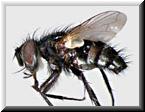Reared specimens examined. Phryxe pecosensis (Townsend): One specimen reared from bertha armyworm collected from Dauphin, Manitoba on 18 August 1979 (UMW).
There are two species of Phryxe in the Nearctic region, P. pecosensis (Townsend) and P. vulgaris (Fallén). Both species have been recorded from bertha armyworm in Manitoba: P. pecosensis by Wylie and Bucher (1977) and Turnock (1984), and P. vulgaris by Turnock (1984). Their parasitism of bertha armyworm is apparently rare. Phryxe vulgaris is also present in the Palearctic region where it has been recorded from many hosts including Mamestra brassicae (Turnock 1984).
Recognition. The following characteristics distinguish Phryxe from other genera of Nearctic Tachinidae: dark coloured, eye haired, parafacial bare, facial ridge with fine hairs on 1/3 to 1/2 length, third aristomere thickened on basal 2/3 or less, prosternum haired, first postsutural supra-alar seta at least as long and stout as first postsutural dorsocentral seta, postpronotum with basal setae forming nearly straight line (not forming triangle), katepisternum with three setae arranged quite close together, apical scutellar setae strong, upturned and usually crossed, abdomen with 1 pair median marginal setae on T1+2 and T3 and 1 pair median discal setae on T3 and T4 (additional discals in some specimens). Sabrosky and Reardon (1976) provide a detailed description of P. vulgaris, which applies to P. pecosensis equally well.
Sellers (1943) differentiates between P. vulgaris and P. pecosensis based on a number of characteristics. These are not totally reliable but are helpful. Two of the better differences are apparent with the unaided eye: P. vulgaris tends to be larger (typically 6.5-8.5 mm in length compared to 5.5-7.5 mm in P. pecosensis) and more pruinose. The most noticeable manifestation of the latter is that the 4 mesonotal vittae common to Phryxe species are more apparent in P. vulgaris than in P. pecosensis; the sparse pruinosity in P. pecosensis makes the mesonotum appear more shiny black and the vittae barely (if at all) discernible in that species. Examination of the male genitalia did not reveal any differences between these two species. One is apt to have difficulty identifying specimens of this species complex without verified specimens of both species on hand for comparison, and even then placement of some specimens may be questionable.
The immature stages of P. vulgaris were described and illustrated by Bisset (1938) and those of P. pecosensis by Maw and Coppel (1953). The puparium of P. pecosensis was illustrated by Ross (1952). Sabrosky and Reardon (1976) figure a puparium of "Phryxe" and note that its features are "virtually identical" in P. vulgaris and P. pecosensis.
Biology. The life cycles of P. pecosensis and P. vulgaris are apparently quite similar. Adult females deposit "banana-shaped" eggs directly on their hosts (Sellers 1943, Maw and Coppel 1953) and the eggs hatch in minutes to hours depending upon the stage of development of the female reproductive system (Maw and Coppel 1953). There are two or more generations per year, adults are active from May to October, one to occasionally several larvae develop per host, and larvae overwinter in host pupae (Schaffner and Griswold 1943, as Zenillia vulgaris; Sellers 1943).
Phryxe pecosensis and P. vulgaris are so similar that some misidentifications have probably occurred with regard to host records. Nevertheless, the published records can be summarized as follows: hosts of P. pecosensis include a tenthredinid sawfly and Lepidoptera belonging to the Danaidae, Geometridae, Hesperiidae, Noctuidae, Pieridae, Pyralidae, Saturniidae, and Tortricidae; hosts of P. vulgaris include species of the Danaidae, Geometridae, Lymantriidae, Noctuidae, Pieridae, Pyralidae, Saturniidae, and Tortricidae (Arnaud 1978). Interestingly, P. pecosensis has been reared frequently from spruce budworm, Choristoneura fumiferana (Clemens) and P. vulgaris seldom from that host, whereas P. vulgaris is a common parasitoid of the imported cabbageworm, Pieris rapae (L.) which is not a recorded host of P. pecosensis (though used by Maw and Coppel 1953 in laboratory studies on P. pecosensis biology) (Arnaud 1978).
Distribution. Phryxe pecosensis has a recorded distribution of "Alaska, British Columbia to Newfoundland, south to California, New Mexico, and Massachusetts" (Sabrosky and Arnaud 1965: 1105). Sabrosky and Reardon (1976: 76) cite the distribution of P. vulgaris as "Widespread in Palearctic region, Europe to Japan; Nearctic region, British Columbia and Idaho to California, also northeastern Wisconsin to New Brunswick and New Jersey."


